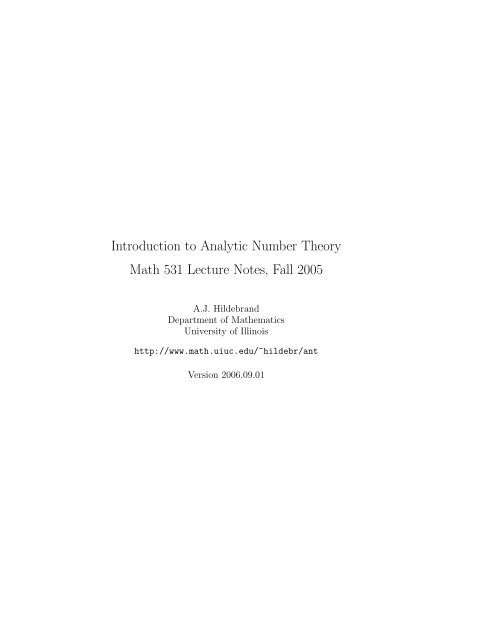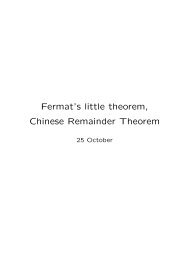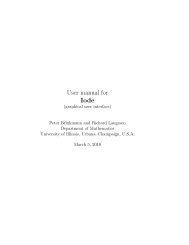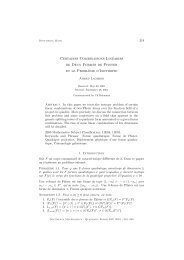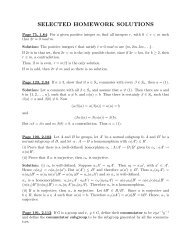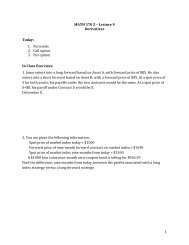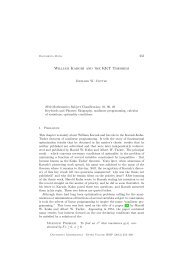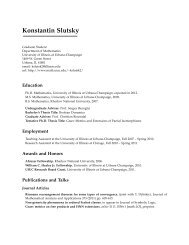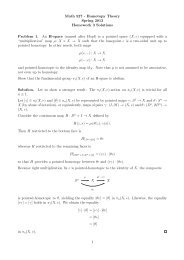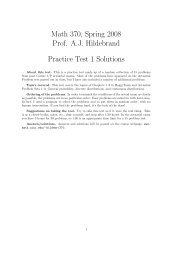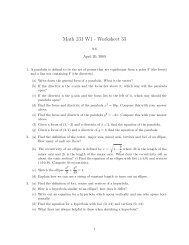Introduction to Analytic Number Theory Math 531 ... - Mathematics
Introduction to Analytic Number Theory Math 531 ... - Mathematics
Introduction to Analytic Number Theory Math 531 ... - Mathematics
You also want an ePaper? Increase the reach of your titles
YUMPU automatically turns print PDFs into web optimized ePapers that Google loves.
<strong>Introduction</strong> <strong>to</strong> <strong>Analytic</strong> <strong>Number</strong> <strong>Theory</strong><br />
<strong>Math</strong> <strong>531</strong> Lecture Notes, Fall 2005<br />
A.J. Hildebrand<br />
Department of <strong>Math</strong>ematics<br />
University of Illinois<br />
http://www.math.uiuc.edu/~hildebr/ant<br />
Version 2006.09.01
18<br />
<strong>Math</strong> <strong>531</strong> Lecture Notes, Fall 2005 Version 2006.09.01
Chapter 1<br />
Arithmetic functions I:<br />
Elementary theory<br />
1.1 <strong>Introduction</strong> and basic examples<br />
A simple, but very useful concept in number theory is that of an arithmetic<br />
function. An arithmetic function is any real- or complex-valued function<br />
defined on the set N of positive integers. (In other words, an arithmetic<br />
function is just a sequence of real or complex numbers, though this point of<br />
view is not particularly useful.)<br />
Examples<br />
(1) Constant function: The function defined by f(n) = c for all n,<br />
where c is a constant, is denoted by c; in particular, 1 denotes the<br />
function that is equal <strong>to</strong> 1 for all n.<br />
(2) Unit function: e(n), defined by e(1) = 1 and e(n) = 0 for n ≥ 2.<br />
(3) Identity function: id(n); defined by id(n) = n for all n.<br />
(4) Logarithm: log n, the (natural) logarithm, restricted <strong>to</strong> N and regarded<br />
as an arithmetic function.<br />
(5) Moebius function: µ(n), defined by µ(1) = 1, µ(n) = 0 if n is not<br />
squarefree (i.e., divisible by the square of a prime), and µ(n) = (−1) k<br />
if n is composed of k distinct prime fac<strong>to</strong>rs (i.e., n = � k<br />
i pi).<br />
19
20 CHAPTER 1. ARITHMETIC FUNCTIONS I<br />
(6) Characteristic function of squarefree integers: µ 2 (n) or |µ(n)|.<br />
From the definition of the Moebius function, it follows that the absolute<br />
value (or, equivalently, the square) of µ is the characteristic<br />
function of the squarefree integers.<br />
(7) Liouville function: λ(n), defined by λ(1) = 1 and λ(n) = (−1) k<br />
if n is composed of k not necessarily distinct prime fac<strong>to</strong>rs (i.e., if<br />
n = �k i=1 pαi<br />
i then λ(n) = �k i=1 (−1)αi ).<br />
(8) Euler phi (<strong>to</strong>tient) function: φ(n), the number of positive integers<br />
m ≤ n that are relatively prime <strong>to</strong> n; i.e., φ(n) = � n<br />
m=1,(m,n)=1 1.<br />
(9) Divisor function: d(n), the number of positive divisors of n (including<br />
the trivial divisors d = 1 and d = n); i.e., d(n) = �<br />
d|n 1. (Another<br />
common notation for this function is τ(n).)<br />
(10) Sum-of-divisors function: σ(n), the sum over all positive divisors<br />
of n; i.e., σ(n) = �<br />
d|n d.<br />
(11) Generalized sum-of-divisors functions: σα(n), defined by<br />
σα(n) = �<br />
d|n dα . Here α can be any real or complex parameter.<br />
This function generalizes the divisor function (α = 0) and the sum-ofdivisors<br />
function (α = 1).<br />
(12) <strong>Number</strong> of distinct prime fac<strong>to</strong>rs: ω(n), defined by ω(1) = 0 and<br />
ω(n) = k if n ≥ 2 and n = �k i=1 pαi<br />
i ; i.e., ω(n) = �<br />
p|n 1.<br />
(13) Total number of prime divisors: Ω(n), defined in the same way as<br />
ω(n), except that prime divisors are counted with multiplicity. Thus,<br />
Ω(1) = 0 and Ω(n) = �k i=1 αi if n ≥ 2 and n = �k i=1 pαi<br />
i ; i.e., Ω(n) =<br />
1. For squarefree integers n, the functions ω(n) and Ω(n) are<br />
�<br />
pm |n<br />
equal and are related <strong>to</strong> the Moebius function by µ(n) = (−1) ω(n) .<br />
For all integers n, λ(n) = (−1) Ω(n) .<br />
(14) Ramanujan sums: Given a positive integer q, the Ramanujan sum<br />
cq is the arithmetic function defined by cq(n) = � q<br />
a=1,(a,q)=1 e2πian/q .<br />
(15) Von Mangoldt function: Λ(n), defined by Λ(n) = 0 if n is not a<br />
prime power, and Λ(p m ) = log p for any prime power p m .<br />
<strong>Math</strong> <strong>531</strong> Lecture Notes, Fall 2005 Version 2006.09.01
INTRODUCTION TO ANALYTIC NUMBER THEORY 21<br />
1.2 Additive and multiplicative functions<br />
Many important arithmetic functions are multiplicative or additive functions,<br />
in the sense of the following definition.<br />
Definition. An arithmetic function f is called multiplicative if f �≡ 0 and<br />
(1.1) f(n1n2) = f(n1)f(n2) whenever (n1, n2) = 1;<br />
f is called additive if it satisfies<br />
(1.2) f(n1n2) = f(n1) + f(n2) whenever (n1, n2) = 1.<br />
If this condition holds without the restriction (n1, n2) = 1, then f is called<br />
completely (or <strong>to</strong>tally) multiplicative resp. completely (or <strong>to</strong>tally)<br />
additive.<br />
The condition (1.1) can be used <strong>to</strong> prove the multiplicativity of a given<br />
function. (There are also other, indirect, methods for establishing multiplicativity,<br />
which we will discuss in the following sections.) However, in<br />
order <strong>to</strong> exploit the multiplicativity of a function known <strong>to</strong> be multiplicative,<br />
the criterion of the following theorem is usually more useful.<br />
Theorem 1.1 (Characterization of multiplicative functions). An<br />
arithmetic function f is multiplicative if and only if f(1) = 1 and, for n ≥ 2,<br />
(1.3) f(n) = �<br />
p m ||n<br />
f(p m ).<br />
The function f is completely multiplicative if and only if the above condition<br />
is satisfied and, in addition, f(p m ) = f(p) m for all prime powers p m .<br />
Remarks. (i) The result shows that a multiplicative function is uniquely<br />
determined by its values on prime powers, and a completely multiplicative<br />
function is uniquely determined by its values on primes.<br />
(ii) With the convention that an empty product is <strong>to</strong> be interpreted as<br />
1, the condition f(1) = 1 can be regarded as the special case n = 1 of (1.3).<br />
With this interpretation, f is multiplicative if and only if f satisfies (1.3)<br />
for all n ∈ N.<br />
Proof. Suppose first that f satisfies f(1) = 1 and (1.3) for n ≥ 2. If n1 and<br />
n2 are positive integers with (n1, n2) = 1, then the prime fac<strong>to</strong>rizations of<br />
n1 and n2 involve disjoint sets of prime powers, so expressing each of f(n1),<br />
<strong>Math</strong> <strong>531</strong> Lecture Notes, Fall 2005 Version 2006.09.01
22 CHAPTER 1. ARITHMETIC FUNCTIONS I<br />
f(n2), and f(n1n2) by (1.3) we see that f satisfies (1.1). Moreover, since<br />
f(1) = 1, f cannot be identically 0. Hence f is multiplicative.<br />
Conversely, suppose that f is multiplicative. Then f is not identically<br />
0, so there exists n ∈ N such that f(n) �= 0. Applying (1.3) with (n1, n2) =<br />
(n, 1), we obtain f(n) = f(1 · n) = f(1)f(n), which yields f(1) = 1, upon<br />
dividing by f(n).<br />
Next, let n ≥ 2 be given with prime fac<strong>to</strong>rization n = �k i=1 pαi<br />
i . “Shaving<br />
off” prime powers one at a time, and applying (1.3) inductively, we have<br />
f(n) = f � p α1<br />
1<br />
� � α1<br />
· · · pαk<br />
k = f p1 � � � αk<br />
· · · pαk−1<br />
k−1 f pk = · · · = f (p α1<br />
1 ) · · · f � p αk<br />
�<br />
k ,<br />
so (1.3) holds.<br />
If f is completely multiplicative, then for any prime power p m we have<br />
f(p m ) = f(p m−1 · p) = f(p m−1 )f(p) = · · · = f(p) m−1 .<br />
Conversely, if f is multiplicative and satisfies f(p m ) = f(p) m for all prime<br />
powers p m , then (1.3) can be written as f(n) = � r<br />
i=1 f(pi), where now n =<br />
� r<br />
i=1 pi is the fac<strong>to</strong>rization of n in<strong>to</strong> single (not necessarily distinct) prime<br />
fac<strong>to</strong>rs pi. Since, for any two positive integers n1 and n2, the product of the<br />
corresponding fac<strong>to</strong>rizations is the fac<strong>to</strong>rization of the product, it follows<br />
that the multiplicativity property f(n1n2) = f(n1)f(n2) holds for any pair<br />
(n1, n2) of positive integers. Hence f is completely multiplicative.<br />
Theorem 1.2 (Products and quotients of multiplicative functions).<br />
Assume f and g are multiplicative function. Then:<br />
(i) The (pointwise) product fg defined by (fg)(n) = f(n)g(n) is multiplicative.<br />
(ii) If g is non-zero, then the quotient f/g (again defined pointwise) is<br />
multiplicative.<br />
Proof. The result is immediate from the definition of multiplicativity.<br />
Analogous properties hold for additive functions: an additive function<br />
satisfies f(1) = 0 and f(n) = �<br />
pm ||m f(pm ), and the pointwise sums and<br />
differences of additive functions are additive.<br />
Tables 1.1 and 1.2 below list the most important multiplicative and additive<br />
arithmetic functions, along with their values at prime powers, and<br />
basic properties. (Properties that are not obvious from the definition will<br />
be established in the following sections.)<br />
<strong>Math</strong> <strong>531</strong> Lecture Notes, Fall 2005 Version 2006.09.01
INTRODUCTION TO ANALYTIC NUMBER THEORY 23<br />
Function value at n value at p m properties<br />
e(n) 1 if n = 1,<br />
0 else<br />
id(n) (identity<br />
function)<br />
s(n) (char. fct.<br />
of squares)<br />
µ 2 (n) (char.<br />
fct. of<br />
squarefree<br />
integers)<br />
µ(n) (Moebius<br />
function)<br />
λ(n) (Liouville<br />
function)<br />
φ(n) (Euler phi<br />
function)<br />
d(n) (= τ(n))<br />
(divisor<br />
function)<br />
σ(n) (sum of<br />
divisor<br />
function)<br />
n p m<br />
1 if n = m 2<br />
with m ∈ N,<br />
0 else<br />
1 if n is<br />
squarefree,<br />
0 else<br />
1 if n = 1,<br />
(−1) k if<br />
n = � k<br />
i=1 pi<br />
(pi distinct),<br />
0 otherwise<br />
1 if n = 1,<br />
(−1) �k i=1 αi if<br />
n = �k i=1 pαi<br />
i<br />
#{1 ≤ m ≤ n :<br />
(m, n) = 1}<br />
0 unit element<br />
w.r.t. Dirichlet<br />
product,<br />
e ∗ f =f ∗ e=f<br />
1 if m is even,<br />
0 if m is odd<br />
1 if m = 1,<br />
0 if m > 1<br />
−1 if m = 1,<br />
0 if m > 1<br />
(−1) m<br />
p m (1 − 1/p)<br />
�<br />
d|n µ(d) = 0 if<br />
n ≥ 2<br />
µ ∗ 1 = e<br />
�<br />
d|n λ(d) = n2<br />
λ ∗ 1 = s<br />
�<br />
d|n φ(d) = n<br />
φ ∗ 1 = id<br />
�<br />
d|n 1 m + 1 d = 1 ∗ 1<br />
�<br />
d|n d<br />
p m+1 − 1<br />
p − 1<br />
σ = 1 ∗ id<br />
Table 1.1: Some important multiplicative functions<br />
<strong>Math</strong> <strong>531</strong> Lecture Notes, Fall 2005 Version 2006.09.01
24 CHAPTER 1. ARITHMETIC FUNCTIONS I<br />
Function value at n value at p m properties<br />
ω(n) (number<br />
of distinct<br />
prime<br />
fac<strong>to</strong>rs)<br />
Ω(n) (<strong>to</strong>tal<br />
number of<br />
prime<br />
fac<strong>to</strong>rs)<br />
log n<br />
(logarithm)<br />
Λ(n) (von<br />
Mangoldt<br />
function)<br />
0 if n = 1,<br />
k if<br />
n = � k<br />
i=1 pαi<br />
i<br />
0 if n = 1,<br />
� k<br />
i=1 αi if<br />
n = � k<br />
i=1 pαi<br />
i<br />
1 additive<br />
m completely<br />
additive<br />
log n log p m completely<br />
additive<br />
log p if n = p m ,<br />
0 if n is not a<br />
prime power<br />
log p neither additive<br />
nor<br />
multiplicative<br />
log = Λ ∗ 1<br />
Table 1.2: Some other important arithmetic functions<br />
1.3 The Moebius function<br />
The fundamental property of the Moebius function is given in the following<br />
theorem.<br />
Theorem 1.3 (Moebius identity). For all n ∈ N, �<br />
d|n µ(d) = e(n); i.e.,<br />
the sum �<br />
d|n µ(d) is zero unless n = 1, in which case it is 1.<br />
Proof. There are many ways <strong>to</strong> prove this important identity; we give here<br />
a combina<strong>to</strong>rial proof that does not require any special tricks or techniques.<br />
We will later give alternate proofs, which are simpler and more elegant, but<br />
which depend on some results in the theory of arithmetic functions.<br />
If n = 1, then the sum �<br />
d|n µ(d) reduces <strong>to</strong> the single term µ(1) = 1,<br />
so the asserted formula holds in this case. Next, suppose n ≥ 2 and let<br />
n = � k<br />
i=1 pαi<br />
i<br />
be the canonical prime fac<strong>to</strong>rization of n. Since µ(d) = 0 if<br />
d is not squarefree, the sum over d can be restricted <strong>to</strong> divisors of the form<br />
d = �<br />
i∈I pi, where I ⊂ {1, 2, . . . , k}, and each such divisor contributes a<br />
<strong>Math</strong> <strong>531</strong> Lecture Notes, Fall 2005 Version 2006.09.01
INTRODUCTION TO ANALYTIC NUMBER THEORY 25<br />
term µ(d) = (−1) |I| . Hence,<br />
�<br />
µ(d) = �<br />
d|n<br />
I⊂{1,...,k}<br />
(−1) |I| .<br />
Now note that, for any r ∈ {0, 1, . . . , k}, there are � � k<br />
r subsets I with |I| = r,<br />
and for each such subset the summand (−1) |I| is equal <strong>to</strong> (−1) r . Hence the<br />
above sum reduces <strong>to</strong><br />
k�<br />
(−1) r<br />
� �<br />
k<br />
= (1 − 1)<br />
r<br />
k = 0,<br />
r=0<br />
by the binomial theorem. (Note that k ≥ 1, since we assumed n ≥ 2.) Hence<br />
we have �<br />
d|n µ(d) = 0 for n ≥ 2, as claimed.<br />
Motivation for the Moebius function. The identity given in this theorem<br />
is the main reason for the peculiar definition of the Moebius function,<br />
which may seem rather artificial. In particular, the definition of µ(n) as 0<br />
when n is not squarefree appears <strong>to</strong> be unmotivated. The Liouville function<br />
λ(n), which is identical <strong>to</strong> the Moebius function on squarefree integers,<br />
but whose definition extends <strong>to</strong> non-squarefree integers in a natural way,<br />
appears <strong>to</strong> be a much more natural function <strong>to</strong> work with. However, this<br />
function does not satisfy the identity of the theorem, and it is this identity<br />
that underlies most of the applications of the Moebius function.<br />
Application: Evaluation of sums involving a coprimality condition.<br />
The identity of the theorem states that �<br />
d|n µ(d) is the characteristic function<br />
of the integer n = 1. This fact can be used <strong>to</strong> extract specific terms<br />
from a series. A typical application is the evaluation of sums over integers n<br />
that are relatively prime <strong>to</strong> a given integer k. By the theorem, the characteristic<br />
function of integers n with (n, k) = 1 is given by �<br />
d|(n,k) µ(d). Since<br />
the condition d|(n, k) is equivalent <strong>to</strong> the simultaneous conditions d|n and<br />
d|k, one can formally rewrite a sum �<br />
n,(n,k)=1 f(n) as follows:<br />
�<br />
f(n) = �<br />
f(n)e((n, k)) = �<br />
f(n) �<br />
µ(n)<br />
n<br />
(n,k)=1<br />
n<br />
n<br />
d|(n,k)<br />
= �<br />
µ(d) �<br />
f(n) = �<br />
µ(d) �<br />
f(dm).<br />
d|k<br />
n<br />
d|n<br />
<strong>Math</strong> <strong>531</strong> Lecture Notes, Fall 2005 Version 2006.09.01<br />
d|k<br />
m
26 CHAPTER 1. ARITHMETIC FUNCTIONS I<br />
The latter sum can usually be evaluated, and doing so yields a formula for<br />
the original sum. (Of course, one has <strong>to</strong> make sure that the series involved<br />
converge.) The following examples illustrate the general method.<br />
Evaluation of the Euler phi function. By definition, the Euler phi<br />
function is given by φ(n) = �<br />
m≤n,(m,n)=1 1. Eliminating the coprimality<br />
condition (m, n) = 1, as indicated above, yields the identity<br />
φ(n) = �<br />
�<br />
m≤n d|(m,n)<br />
µ(d) = �<br />
µ(d) �<br />
d|n<br />
m≤n,d|m<br />
(For an alternative proof of this identity see Section 1.7.)<br />
1 = �<br />
µ(d)(n/d).<br />
Ramanujan sums. The functions cq(n) = �q a=1,(a,q)=1 exp(2πian/q),<br />
where q is a positive integer, are called Ramanujan sums. By eliminating<br />
the condition (a, q) = 1 using the above method, one can show that<br />
cq(n) = �<br />
d|(q,n) dµ(q/d). When n = 1, this formula reduces <strong>to</strong> cq(1) = µ(q),<br />
and we obtain the remarkable identity � q<br />
a=1,(a,q)=1<br />
d|n<br />
exp(2πia/q) = µ(q),<br />
which shows that the sum over all “primitive” k-th roots of unity is equal<br />
<strong>to</strong> µ(q).<br />
A weighted average of the Moebius function. While the estimation<br />
of the partial sums of the Moebius function �<br />
n≤x µ(n) is a very deep (and<br />
largely unsolved) problem, remarkably enough a weighted version of this<br />
sum, namely �<br />
n≤x µ(n)/n is easy <strong>to</strong> bound. In fact, we will prove:<br />
Theorem 1.4. For any real x ≥ 1 we have<br />
(1.4)<br />
�<br />
�<br />
��<br />
�<br />
�<br />
�<br />
n≤x<br />
µ(n)<br />
n<br />
�<br />
�<br />
�<br />
�<br />
� ≤ 1.<br />
�<br />
Proof. Note first that, without loss of generality, one can assume that x = N,<br />
where N is a positive integer. We then evaluate the sum S(N) = �<br />
n≤N e(n)<br />
in two different ways. On the one hand, by the definition of e(n), we have<br />
S(N) = 1; on the other hand, writing e(n) = �<br />
d|n µ(d) and interchanging<br />
summations, we obtain S(N) = �<br />
d≤N µ(d)[N/d], where [t] denotes the<br />
greatest integer ≤ t. Now, for d ≤ N − 1, [N/d] differs from N/d by<br />
an amount that is bounded by 1 in absolute value, while for d = N, the<br />
<strong>Math</strong> <strong>531</strong> Lecture Notes, Fall 2005 Version 2006.09.01
INTRODUCTION TO ANALYTIC NUMBER THEORY 27<br />
quantities [N/d] and N/d are equal. Replacing [N/d] by N/d and bounding<br />
the resulting error, we therefore obtain<br />
�<br />
�<br />
� �<br />
�<br />
�S(N)<br />
− N<br />
�<br />
Hence,<br />
d≤N<br />
�<br />
�<br />
� �<br />
�<br />
�N<br />
�<br />
d≤N<br />
µ(d)<br />
d<br />
which proves (1.4).<br />
�<br />
�<br />
� �<br />
�<br />
� ≤ |µ(d)| · |[N/d] − (N/d)| ≤<br />
� �<br />
µ(d)<br />
d<br />
d≤N<br />
d≤N−1<br />
�<br />
�<br />
�<br />
�<br />
� ≤ (N − 1) + |S(N)| = (N − 1) + 1 = N,<br />
�<br />
|µ(d)| ≤ N − 1.<br />
The Moebius function and the Prime <strong>Number</strong> Theorem. Part of<br />
the interest in studying the Moebius function stems from the fact that the<br />
behavior of this function is intimately related <strong>to</strong> the Prime <strong>Number</strong> Theorem<br />
(PNT), which says that the number π(x) of primes below x is asymp<strong>to</strong>tically<br />
equal <strong>to</strong> x/ log x as x → ∞ and which is one of the main results<br />
of <strong>Analytic</strong> <strong>Number</strong> <strong>Theory</strong>. We will show later that the PNT is “equivalent”<br />
<strong>to</strong> the fact that µ(n) has average value (“mean value”) zero, i.e.,<br />
limx→∞(1/x) �<br />
n≤x<br />
µ(n) = 0. The latter statement can has the following<br />
probabilistic interpretation: If a squarefree integer is chosen at random, then<br />
it is equally likely <strong>to</strong> have an even and an odd number of prime fac<strong>to</strong>rs.<br />
Mertens’ conjecture. A famous conjecture, attributed <strong>to</strong> Mertens<br />
(though it apparently was first stated by Stieltjes who mistakenly believed<br />
that he had proved it) asserts that | �<br />
n≤x µ(n)| ≤ √ x for all x ≥ 1. This<br />
conjecture had remained open for more than a century, but was disproved<br />
(though only barely!) in 1985 by A. Odlyzko and H. te Riele, who used<br />
extensive computer calculations, along with some theoretical arguments, <strong>to</strong><br />
show that the above sum exceeds 1.06 √ x for infinitely many x. Whether<br />
the constant 1.06 can be replaced by any constant c is still an open problem.<br />
Heuristic arguments, based on the assumption that the values ±1 of<br />
the Moebius function on squarefree integers are distributed like a random<br />
sequence of numbers ±1, strongly suggest that this is the case, but a proof<br />
has remained elusive so far.<br />
<strong>Math</strong> <strong>531</strong> Lecture Notes, Fall 2005 Version 2006.09.01
28 CHAPTER 1. ARITHMETIC FUNCTIONS I<br />
1.4 The Euler phi (<strong>to</strong>tient) function<br />
Theorem 1.5. The Euler phi function satisfies:<br />
(i) �<br />
d|n φ(d) = n for all n ∈ N.<br />
(ii) φ(n) = �<br />
d|n µ(d)(n/d).<br />
(iii) φ is multiplicative.<br />
(iv) φ(n) = �<br />
pm ||n (pm − pm−1 ) = n �<br />
p|n (1 − 1/p) for all n ∈ N.<br />
Proof. (i) Split the set A = {1, 2, . . . , n} in<strong>to</strong> the pairwise disjoint subsets<br />
Ad = {m ∈ A : (m, n) = d}, d|n. Writing an element m ∈ Ad as m =<br />
dm ′ , we see that Ad = {dm ′ : 1 ≤ m ′ ≤ n/d, (m ′ , n/d) = 1}, and so<br />
|Ad| = φ(n/d). Since n = |A| = �<br />
d|n |Ad|, it follows that n = �<br />
d|n φ(n/d).<br />
Writing d ′ = n/d and noting that, as d runs over all positive divisors of n,<br />
so does d ′ , we obtain the desired identity.<br />
(ii) This identity was proved in the last section. Alternatively, as we<br />
shall show in Section 1.7, one can derive it from the identity (i).<br />
(ii) We defer the proof of the multiplicativity until Section 1.7.<br />
(iv) This follows immediately from the multiplicativity of φ and the fact<br />
that, at n = pm , φ(pm ) = pm − pm−1 . To see the latter formula, note that<br />
an integer is relatively prime <strong>to</strong> pm if and only if it is not a multiple of p and<br />
that of the pm positive integers ≤ pm exactly pm−1 are multiples of p.<br />
Formula (iii) of the theorem can be used <strong>to</strong> quickly compute values of<br />
φ. For example, the first 7 values are φ(1) = 1, φ(2) = (2 − 1) = 1,<br />
φ(3) = (3 − 1) = 2, φ(4) = (2 2 − 2) = 2, φ(5) = (5 − 1) = 4, φ(6) = φ(2 · 3) =<br />
(2 − 1)(3 − 1) = 2, φ(7) = (7 − 1) = 6.<br />
Carmichael’s conjecture. It is easy <strong>to</strong> see that not every positive integer<br />
occurs as a value of φ; for example, φ(n) is never equal <strong>to</strong> an odd prime. In<br />
other words, the range of φ is a proper subset of N. At the beginning of this<br />
century, R.D. Carmichael, a professor at the University of Illinois and author<br />
of a textbook on number theory, observed that there seems <strong>to</strong> be no integer<br />
that appears exactly once as a value of φ; in other words, for each m ∈ N,<br />
the pre-image φ −1 (m) = {n ∈ N : φ(n) = m} has either cardinality 0 or has<br />
cardinality ≥ 2. In fact, Carmichael claimed <strong>to</strong> have a proof of this result<br />
and included the “proof” as an exercise in his number theory textbook, but<br />
his “proof” was incorrect, and he later retracted the claim; he changed the<br />
<strong>Math</strong> <strong>531</strong> Lecture Notes, Fall 2005 Version 2006.09.01
INTRODUCTION TO ANALYTIC NUMBER THEORY 29<br />
wording of the exercise, calling the result an “empirical theorem.” This<br />
“empirical theorem” is still open <strong>to</strong> this date, and has become a famous<br />
conjecture, known as “Carmichael’s conjecture,” The numerical evidence<br />
for the conjecture is overwhelming: the conjecture (that the cardinality of<br />
φ−1 (m) is never 1) is true for values m up <strong>to</strong> 101010. While the conjecture is<br />
still open, Kevin Ford, a former UIUC graduate student and now a faculty<br />
member here, proved a number of related conjectures. In particular, he<br />
showed that for every integer k ≥ 2 there exist infinitely many m such that<br />
φ−1 (m) has cardinality k. This was known as “Sierpinski’s conjecture”,<br />
and it complements Carmichael’s conjecture which asserts that in the case<br />
k = 1, the only case not covered by Sierpinski’s conjecture, the assertion of<br />
Sierpinski’s conjecture is not true.<br />
1.5 The von Mangoldt function<br />
The definition of the von Mangoldt function may seem strange at first glance.<br />
One motivation for this peculiar definition lies in the following identity.<br />
Theorem 1.6. We have<br />
�<br />
Λ(d) = log n (n ∈ N).<br />
d|n<br />
Proof. For n = 1, the identity holds since Λ(1) = 0 = log 1. For n ≥ 2 we<br />
have, by the definition of Λ,<br />
�<br />
Λ(d) = �<br />
log p = log n.<br />
d|n<br />
p m |n<br />
(For the last step note that, for each prime power pα ||n, each of the terms<br />
p1 , p2 , . . . , pα contributes a term log p <strong>to</strong> the sum, so the <strong>to</strong>tal contribution<br />
arising from powers of p is α(log p) = log pα . Adding up those contributions<br />
over all prime powers pα ||n, gives �<br />
pα ||n log pα = log �<br />
pα ||n pα = log n.)<br />
The main motivation for introducing the von Mangoldt function is that<br />
the partial sums �<br />
n≤x Λ(n) represent a weighted count of the prime powers<br />
pm ≤ x, with the weights being log p, the “correct” weights <strong>to</strong> offset the<br />
density of primes. It is not hard <strong>to</strong> show that higher prime powers (i.e.,<br />
those with m ≥ 2) contribute little <strong>to</strong> the above sum, so the sum is essentially<br />
a weighted sum over prime numbers. In fact, studying the asymp<strong>to</strong>tic<br />
behavior of the above sum is essentially equivalent <strong>to</strong> studying the behavior<br />
<strong>Math</strong> <strong>531</strong> Lecture Notes, Fall 2005 Version 2006.09.01
30 CHAPTER 1. ARITHMETIC FUNCTIONS I<br />
of the prime counting function π(x); for example, the PNT is equivalent <strong>to</strong><br />
the assertion that limx→∞(1/x) �<br />
n≤x Λ(n) = 1. In fact, most proofs of the<br />
PNT proceed by first showing the latter relation, and then deducing from<br />
this the original form of the PNT. The reason for doing this is that, because<br />
of the identity in the above theorem (and some similar relations), working<br />
with Λ(n) is technically easier than working directly with the characteristic<br />
function of primes.<br />
1.6 The divisor and sum-of-divisors functions<br />
Theorem 1.7. The divisor function d(n) and the sum-of-divisors function<br />
σ(n) are multiplicative. Their values at prime powers are given by<br />
d(p m ) = m + 1, σ(p m ) = pm+1 − 1<br />
p − 1 .<br />
Proof. To prove the multiplicativity of d(n), let n1 and n2 be positive integers<br />
with (n1, n2) = 1. Note that if d1|n1 and d2|n2, then d1d2|n1n2.<br />
Conversely, by the coprimality condition and the fundamental theorem of<br />
arithmetic, any divisor d of n1n2 fac<strong>to</strong>rs uniquely in<strong>to</strong> a product d = d1d2,<br />
where d1|n1 and d2|n2. Thus, there is a 1 − 1 correspondence between the<br />
set of divisors of n1n2 and the set of pairs (d1, d2) with d1|n1 and d2|n2.<br />
Since there are d(n1)d(n2) such pairs and d(n1n2) divisors of n1n2, we obtain<br />
d(n1n2) = d(n1)d(n2), as required. The multiplicativity of σ(n) can be<br />
proved in the same way. (Alternate proofs of the multiplicativity of d and<br />
σ will be given in the following section.)<br />
The given values for d(p m ) and σ(p m ) are obtained on noting that the<br />
divisors of p m are exactly the numbers p 0 , p 1 , . . . , p m . Since there are m + 1<br />
such divisors, we have d(p m ) = m + 1, and applying the geometric series<br />
formula <strong>to</strong> the sum of these divisors gives the asserted formula for σ(p m ).<br />
Perfect numbers. The sum-of-divisors function is important because of<br />
its connection <strong>to</strong> so-called perfect numbers, that is, positive integers n<br />
that are equal <strong>to</strong> the sum of all their proper divisors, i.e., all positive divisors<br />
except n itself. Since the divisor d = n is counted in the definition of σ(n),<br />
the sum of proper divisors of n is σ(n) − n. Thus, an integer n is perfect if<br />
and only if σ(n) = 2n. For example, 6 is perfect, since 6 = 1 + 2 + 3. It is<br />
an unsolved problem whether there exist infinitely many perfect numbers.<br />
However, a result of Euler states:<br />
<strong>Math</strong> <strong>531</strong> Lecture Notes, Fall 2005 Version 2006.09.01
INTRODUCTION TO ANALYTIC NUMBER THEORY 31<br />
Theorem (Euler). An even integer n is perfect if and only if n is of the<br />
form n = 2 p−1 (2 p − 1) where p is a prime and 2 p − 1 is also prime.<br />
This result is not hard <strong>to</strong> prove, using the multiplicity of σ(n). The<br />
problem with this characterization is that it is not known whether there<br />
exist infinitely many primes p such that 2 p − 1 is also prime. (Primes of this<br />
form are called Mersenne primes, and whether there exist infinitely many of<br />
these is another famous open problem.)<br />
There is no analogous characterization of odd perfect numbers; in fact,<br />
no single odd perfect number has been found, and it is an open problem<br />
whether odd perfect numbers exist.<br />
1.7 The Dirichlet product of arithmetic functions<br />
The two obvious operations on the set of arithmetic functions are pointwise<br />
addition and multiplication. The constant functions f = 0 and f = 1<br />
are neutral elements with respect <strong>to</strong> these operations, and the additive and<br />
multiplicative inverses of a function f are given by −f and 1/f, respectively.<br />
While these operations are sometimes useful, by far the most important<br />
operation among arithmetic functions is the so-called Dirichlet product,<br />
an operation that, at first glance, appears mysterious and unmotivated, but<br />
which has proved <strong>to</strong> be an extremely useful <strong>to</strong>ol in the theory of arithmetic<br />
functions.<br />
Definition. Given two arithmetic functions f and g, the Dirichlet product<br />
(or Dirichlet convolution) of f and g, denoted by f ∗ g, is the arithmetic<br />
function defined by<br />
(f ∗ g)(n) = �<br />
f(d)g(n/d).<br />
d|n<br />
In particular, we have (f ∗ g)(1) = f(1)g(1), (f ∗ g)(p) = f(1)g(p) +<br />
f(p)g(1) for any prime p, and (f ∗ g)(pm ) = �m k=0 f(pk )g(pm−k ) for any<br />
prime power pm .<br />
It is sometimes useful <strong>to</strong> write the Dirichlet product in the symmetric<br />
form<br />
(f ∗ g)(n) = �<br />
f(a)g(b),<br />
ab=n<br />
where the summation runs over all pairs (a, b) of positive integers whose<br />
product equals n. The equivalence of the two definitions follows immediately<br />
<strong>Math</strong> <strong>531</strong> Lecture Notes, Fall 2005 Version 2006.09.01
32 CHAPTER 1. ARITHMETIC FUNCTIONS I<br />
from the fact that the pairs (d, n/d), where d runs over all divisors of n, are<br />
exactly the pairs (a, b) of the above form.<br />
One motivation for introducing this product is the fact that the definitions<br />
of many common arithmetic functions have the form of a Dirichlet<br />
product, and that many identities among arithmetic functions can be written<br />
concisely as identities involving Dirichlet products. Here are some examples:<br />
Examples<br />
(1) d(n) = �<br />
d|n 1, so d = 1 ∗ 1.<br />
(2) σ(n) = �<br />
d|n d, so σ = id ∗1.<br />
(3) �<br />
d|n µ(d) = e(n) (see Theorem 1.3), so µ ∗ 1 = e.<br />
(4) �<br />
d|n µ(d)(n/d) = φ(n) (one of the applications of the Moebius identity,<br />
Theorem 1.3), so µ ∗ id = φ.<br />
(5) �<br />
d|n φ(d) = n (Theorem 1.5), so φ ∗ 1 = id.<br />
(6) �<br />
d|n Λ(d) = log n (Theorem 1.6), so Λ ∗ 1 = log.<br />
A second motivation for defining the Dirichlet product in the above manner<br />
is that this product has nice algebraic properties.<br />
Theorem 1.8 (Properties of the Dirichlet product).<br />
(i) The function e acts as a unit element for ∗, i.e., f ∗ e = e ∗ f = f for<br />
all arithmetic functions f.<br />
(ii) The Dirichlet product is commutative, i.e., f ∗ g = g ∗ f for all f and<br />
g.<br />
(iii) The Dirichlet product is associative, i.e., (f ∗ g) ∗ h = f ∗ (g ∗ h) for<br />
all f, g, h.<br />
(iv) If f(1) �= 0, then f has a unique Dirichlet inverse, i.e., there is a<br />
unique function g such that f ∗ g = e.<br />
Proof. (i) follows immediately from the definition of the Dirichlet product.<br />
For the proof of (ii) (commutativity) and (iii) (associativity) it is<br />
useful <strong>to</strong> work with the symmetric version of the Dirichlet product, i.e.,<br />
(f ∗ g)(n) = �<br />
ab=n f(a)g(b). The commutativity of ∗ is immediate from<br />
<strong>Math</strong> <strong>531</strong> Lecture Notes, Fall 2005 Version 2006.09.01
INTRODUCTION TO ANALYTIC NUMBER THEORY 33<br />
this representation. To obtain the associativity, we apply this representation<br />
twice <strong>to</strong> get<br />
((f ∗ g) ∗ h)(n) = �<br />
(f ∗ g)(d)h(c) = � �<br />
f(a)g(b)h(c)<br />
dc=n<br />
= �<br />
abc=n<br />
f(a)g(b)h(c),<br />
dc=n ab=d<br />
where the last sum runs over all triples (a, b, c) of positive integers whose<br />
product is equal <strong>to</strong> n. Replacing (f, g, h) by (g, h, f) in this formula yields<br />
the same final (triple) sum, and we conclude that (f ∗ g) ∗ h = (g ∗ h) ∗ f =<br />
f ∗ (g ∗ h), proving that ∗ is associative.<br />
It remains <strong>to</strong> prove (iv). Let f be an arithmetic function with f(1) �= 0.<br />
By definition, a function g is a Dirichlet inverse of f if (f ∗ g)(1) = e(1) = 1<br />
and (f ∗ g)(n) = e(n) = 0 for all n ≥ 2. Writing out the Dirichlet product<br />
(f ∗ g)(n), we see that this is equivalent <strong>to</strong> the infinite system of equations<br />
(A1)<br />
(An)<br />
f(1)g(1) = 1,<br />
�<br />
g(d)f(n/d) = 0 (n ≥ 2).<br />
d|n<br />
We need <strong>to</strong> show that the system (An) ∞ n=1 has a unique solution g. We<br />
do this by inductively constructing the values g(n) and showing that these<br />
values are uniquely determined.<br />
For n = 1, equation (A1) gives g(1) = 1/f(1), which is well defined since<br />
f(1) �= 0. Hence, g(1) is uniquely defined and (A1) holds. Let now n ≥ 2,<br />
and suppose we have shown that there exist unique values g(1), . . . , g(n −<br />
1) so that equations (A1)–(An−1) hold. Since f(1) �= 0, equation (An) is<br />
equivalent <strong>to</strong><br />
(1.5) g(n) = − 1<br />
f(1)<br />
�<br />
d|n,d
34 CHAPTER 1. ARITHMETIC FUNCTIONS I<br />
(2) Multiplying the identity φ = µ ∗ id (obtained in the last section) by 1<br />
gives φ ∗ 1 = 1 ∗ φ = 1 ∗ µ ∗ id = e ∗ id = id, so we get the identity<br />
φ ∗ 1 = id stated in Theorem 1.5.<br />
The last example is a special case of an important general principle,<br />
which we state as a theorem.<br />
Theorem 1.9 (Moebius inversion formula). If g(n) = �<br />
n ∈ N, then f(n) = �<br />
d|n<br />
g(d)µ(n/d) for all n.<br />
d|n<br />
f(d) for all<br />
Proof. The given relation can be written as g = f ∗ 1. Taking the Dirichlet<br />
product of each side in this relation with the function µ we obtain g ∗ µ =<br />
(f ∗ 1) ∗ µ = f ∗ (1 ∗ µ) = f ∗ e = f, which is the asserted relation.<br />
Finally, a third motivation for the definition of the Dirichlet product is<br />
that it preserves the important property of multiplicativity of a function, as<br />
shown in the following theorem. This is, again, by no means obvious.<br />
Theorem 1.10 (Dirichlet product and multiplicative functions).<br />
(i) If f and g are multiplicative, then so is f ∗ g.<br />
(ii) If f is multiplicative, then so is the Dirichlet inverse f −1 .<br />
(iii) If f ∗ g = h and if f and h are multiplicative, then so is g.<br />
(iv) (Distributivity with pointwise multiplication) If h is completely multiplicative,<br />
then h(f ∗ g) = (hf) ∗ (hg) for any functions f and g.<br />
Remarks. (i) The product of two completely multiplicative functions is multiplicative<br />
(by the theorem), but not necessarily completely multiplicative.<br />
For example, the divisor function d(n) can be expressed as a product 1 ∗ 1<br />
in which each fac<strong>to</strong>r 1 is completely multiplicative, but the divisor function<br />
itself is only multiplicative in the restricted sense (i.e., with the coprimality<br />
condition). The same applies <strong>to</strong> the Dirichlet inverse: if f is completely<br />
multiplicative, then f −1 is multiplicative, but in general not completely<br />
multiplicative.<br />
(ii) By Theorem 1.8, any function f with f(1) �= 0 has a Dirichlet inverse.<br />
Since a multiplicative function satisfies f(1) = 1, any multiplicative function<br />
has a Dirichlet inverse.<br />
(iii) Note that the distributivity asserted in property (iv) only holds<br />
when the function h is completely multiplicative. (In fact, one can show<br />
that this property characterizes completely multiplicative functions: If h is<br />
any non-zero function for which the identity in (iv) holds for all functions f<br />
and g, then h is necessarily completely multiplicative.)<br />
<strong>Math</strong> <strong>531</strong> Lecture Notes, Fall 2005 Version 2006.09.01
INTRODUCTION TO ANALYTIC NUMBER THEORY 35<br />
Proof. (i) Let f and g be multiplicative and let h = f ∗ g. Given n1 and n2<br />
with (n1, n2) = 1, we need <strong>to</strong> show that h(n1n2) = h(n1)h(n2). To this end<br />
we use the fact (see the proof of Theorem 1.7) that each divisor d|n1n2 can<br />
be fac<strong>to</strong>red uniquely as d = d1d2 with d1|n1 and d2|n2, and that, conversely,<br />
given any pair (d1, d2) with d1|n1 and d2|n2, the product d = d1d2 satisfies<br />
d|n1n2. Hence<br />
h(n1n2) = �<br />
d|n1n2<br />
f(d)g(n1n2/d) = �<br />
d1|n1 d2|n2<br />
�<br />
f(d1d2)g((n1n2)/(d1d2)).<br />
Since (n1, n2) = 1, any divisors d1|n1 and d2|n2 satisfy (d1, d2) = 1 and<br />
(n1/d1, n2/d2) = 1. Hence, in the above double sum we can apply the<br />
multiplicativity of f and g <strong>to</strong> obtain<br />
h(n1n2) = � �<br />
f(d1)g(n/d1)f(d2)g(n2/d2)<br />
d1|n1 d2|n2<br />
= (f ∗ g)(n1)(f ∗ g)(n2) = h(n1)h(n2),<br />
which is what we had <strong>to</strong> prove.<br />
(ii) Let f be a multiplicative function and let g be the Dirichlet inverse<br />
of f. We prove the multiplicativity property<br />
(1.6) g(n1n2) = g(n1)g(n2) if (n1, n2) = 1<br />
by induction on the product n = n1n2. If n1n2 = 1, then n1 = n2 = 1, and<br />
(1.6) holds trivially. Let n ≥ 2 be given, and suppose (1.6) holds whenever<br />
n1n2 < n. Let n1 and n2 be given with n1n2 = n and (n1, n2) = 1. Applying<br />
the identity (An) above, we obtain, on using the multiplicativity of f and<br />
that of g for arguments < n,<br />
0 = �<br />
f(d)g(n1n2/d)<br />
d|n1n2<br />
= �<br />
d1|n1 d2|n2<br />
�<br />
f(d1)f(d2)g(n1/d1)g(n2/d2) + (g(n1n2) − g(n1)g(n2))<br />
= (f ∗ g)(n1)(f ∗ g)(n2) + (g(n1n2) − g(n1)g(n2))<br />
= e(n1)e(n2) + (g(n1n2) − g(n1)g(n2)),<br />
= g(n1n2) − g(n1)g(n2),<br />
since, by our assumption n = n1n2 ≥ 2, at least one of n1 and n2 must be<br />
≥ 2, and so e(n1)e(n2) = 0. Hence we have g(n1n2) = g(n1)g(n2). Thus,<br />
<strong>Math</strong> <strong>531</strong> Lecture Notes, Fall 2005 Version 2006.09.01
36 CHAPTER 1. ARITHMETIC FUNCTIONS I<br />
(1.6) holds for pairs (n1, n2) of relatively prime integers with n1n2 = n, and<br />
the induction argument is complete.<br />
(iii) The identity f ∗g = h implies g = f −1 ∗h, where f −1 is the Dirichlet<br />
inverse of f. Since f and h are multiplicative functions, so is f −1 (by (ii))<br />
and f −1 ∗ h (by (i)). Hence g is multiplicative as well.<br />
(iv) If h is completely multiplicative, then for any divisor d|n we have<br />
h(n) = h(d)h(n/d). Hence, for all n,<br />
h(f ∗ g)(n) = h(n) �<br />
f(d)g(n/d) = �<br />
h(d)f(d)h(n/d)g(n/d)<br />
proving (iv).<br />
d|n<br />
= ((hf) ∗ (hg))(n),<br />
Application I: Proving identities for multiplicative arithmetic<br />
functions. The above results can be used <strong>to</strong> provide simple proofs of<br />
identities for arithmetic functions, using the multiplicativity of the functions<br />
involved. To prove an identity of the form f ∗ g = h in the case when<br />
f, g, and h are known <strong>to</strong> be multiplicative functions, one simply shows, by<br />
direct calculation, that (∗) (f ∗ g)(p m ) = h(p m ) holds for every prime power<br />
p m . Since, by the above theorem, the multiplicativity of f and g implies<br />
that of f ∗ g, and since multiplicative functions are uniquely determined by<br />
their values at prime powers, (∗) implies that the identity (f ∗ g)(n) = h(n)<br />
holds for all n ∈ N.<br />
Examples<br />
(1) Alternate proof of the identity �<br />
d|n<br />
d|n<br />
µ(d) = e(n). The identity<br />
can be written as µ ∗ 1 = e, and since all three functions involved<br />
are multiplicative, it suffices <strong>to</strong> verify that the identity holds on prime<br />
powers. Since e(p m ) = 0 and (µ ∗ 1)(p m ) = � m<br />
k=0 µ(pk ) = 1 − 1 + 0 −<br />
0 · · · = 0, this is indeed the case.<br />
(2) Proof of �<br />
d|n µ2 (d)/φ(d) = n/φ(n). This identity is of the form<br />
f ∗ 1 = g with f = µ 2 /φ and g = id /φ. The functions f and g<br />
are both quotients of multiplicative functions and therefore are multiplicative.<br />
Hence all three functions in the identity f ∗ 1 = g are<br />
multiplicative, and it suffices <strong>to</strong> verify the identity at prime powers.<br />
We have g(p m ) = p m /φ(p m ) = p m /(p m − p m−1 ) = (1 − 1/p) −1 , and<br />
(f ∗ 1)(p m ) = � m<br />
k=0 (µ2 (p k )/φ(p k )) = 1 + 1/(p − 1) = (1 − 1/p) −1 , and<br />
<strong>Math</strong> <strong>531</strong> Lecture Notes, Fall 2005 Version 2006.09.01
INTRODUCTION TO ANALYTIC NUMBER THEORY 37<br />
so g(p m ) = (f ∗ 1)(p m ) for every prime power p m . Thus the identity<br />
holds at prime powers, and therefore it holds in general.<br />
(3) The Dirichlet inverse of λ. Since µ ∗ 1 = e, the function 1 is the<br />
Dirichlet inverse of the Moebius function. To find the Dirichlet inverse<br />
of λ, i.e., the unique function f such that λ ∗ f = e, note first that<br />
since λ and e are both multiplicative, f must be multiplicative as well,<br />
and it therefore suffices <strong>to</strong> evaluate f at prime powers. Now, for any<br />
prime power p m ,<br />
0 = e(p m ) =<br />
m�<br />
k=0<br />
f(p k )λ(p m−k ) =<br />
m�<br />
k=0<br />
f(p k )(−1) m−k ,<br />
so f(p m ) = − � m−1<br />
k=0 f(pk )(−1) k . This implies f(p) = 1, and by induction<br />
f(p m ) = 0 for m ≥ 2. Hence f is the characteristic function<br />
of the squarefree numbers, i.e., λ −1 = µ 2 .<br />
Application II: Evaluating Dirichlet products of multiplicative<br />
functions. Since the Dirichlet product of multiplicative functions is multiplicative,<br />
and since a multiplicative function is determined by its values on<br />
prime powers, <strong>to</strong> evaluate a product f ∗ g with both f and g multiplicative,<br />
it suffices <strong>to</strong> compute the values of f ∗ g at prime powers. By comparing<br />
these values <strong>to</strong> those of familiar arithmetic functions, one can often identify<br />
f ∗ g in terms of familiar arithmetic functions.<br />
Examples<br />
(1) The function λ∗1. We have (λ∗1)(pm ) = �m k=0 λ(pk ) = �m k=0 (−1)k ,<br />
which equals 1 if m is even, and 0 otherwise. However, the latter values<br />
are exactly the values at prime powers of the characteristic function<br />
of the squares, which is easily seen <strong>to</strong> be multiplicative. Hence λ ∗ 1 is<br />
equal <strong>to</strong> the characteristic function of the squares.<br />
(2) The function fk(n) = �<br />
µ(d). Here k is a fixed positive<br />
d|n,(d,k)=1<br />
integer, and the summation runs over those divisors of n that are<br />
relatively prime <strong>to</strong> k. We have fk = gk ∗ 1, where gk(n) = µ(n)<br />
if (n, k) = 1 and gk(n) = 0 otherwise. It is easily seen that gk<br />
is multiplicative, so fk is also multiplicative. On prime powers pm ,<br />
gk(pm ) = −1 if m = 1 and p ∤ k and gk(pm ) = 0 otherwise, so<br />
<strong>Math</strong> <strong>531</strong> Lecture Notes, Fall 2005 Version 2006.09.01
38 CHAPTER 1. ARITHMETIC FUNCTIONS I<br />
fk(p m ) = � m<br />
i=0 g(pk ) = 1 − 1 = 0 if p ∤ k, and fk(p m ) = 1 otherwise.<br />
By the multiplicativity of fk it follows that fk is the characteristic<br />
function of the set Ak = {n ∈ N : p|n ⇒ p|k}.<br />
Application III: Proving the multiplicativity of functions, using<br />
known identities. This is, in a sense, the previous application in reverse.<br />
Suppose we kow that f ∗ g = h and that f and h are multiplicative. Then,<br />
by Theorem 1.10, g must be multiplicative as well.<br />
Examples<br />
(1) Multiplicativity of φ. Since φ ∗ 1 = id (see Theorem 1.5) and<br />
the functions 1 and id are (obviously) multiplicative, the function φ<br />
must be multiplicative as well. This is the promised proof of the<br />
multiplicativity of the Euler function (part (ii) of Theorem 1.5).<br />
(2) Multiplicativity of d(n) and σ(n). Since d = 1∗1, and the function<br />
1 is multiplicative, the function d is multiplicative as well. Similarly,<br />
since σ = id ∗1, and 1 and id are multiplicative, σ is multiplicative.<br />
<strong>Math</strong> <strong>531</strong> Lecture Notes, Fall 2005 Version 2006.09.01
INTRODUCTION TO ANALYTIC NUMBER THEORY 39<br />
1.8 Exercises<br />
1.1 Evaluate the function f(n) = �<br />
d2 |n µ(d) (where the summation runs<br />
over all positive integers d such that d2 |n), in the sense of expressing<br />
it in terms of familiar arithmetic functions.<br />
1.2 The unitary divisor function d ∗ (n) is defined as the number of representations<br />
of n as a product of two coprime positive integers, i.e.,<br />
d ∗ (n) = {(a, b) ∈ N 2 : ab = n, (a, b) = 1}.<br />
Show that d ∗ is multiplicative, and find its values on prime powers.<br />
1.3 Determine an arithmetic function f such that<br />
1 � 1<br />
=<br />
φ(n) d<br />
d|n<br />
f<br />
�<br />
n<br />
�<br />
(n ∈ N).<br />
d<br />
1.4 For each of the following arithmetic functions, “evaluate” the function,<br />
or express it in terms of familiar arithmetic functions.<br />
(i) gk(n) = �<br />
µ(d), where k ∈ N is fixed. (Here the sum-<br />
d|n,(d,k)=1<br />
mation runs over all d ∈ N that satisfy d|n and (d, k) = 1.)<br />
(ii) hk(n) = �<br />
d|n,k|d µ(d), where k ∈ N is fixed.<br />
1.5 Show that, for every positive integer n ≥ 2,<br />
�<br />
k = n<br />
2 φ(n).<br />
1≤k≤n−1<br />
(k,n)=1<br />
1.6 Let f(n) = �<br />
d|n µ(d) log d. Find a simple expression for f(n) in terms<br />
of familiar arithmetic functions.<br />
1.7 Let f(n) = #{(n1, n2) ∈ N 2 : [n1, n2] = n}, where [n1, n2] is the least<br />
common multiple of n1 and n2. Show that f is multiplicative and<br />
evaluate f at prime powers.<br />
1.8 Let f be a multiplicative function. We know that the Dirichlet inverse<br />
f −1 is then also multiplicative. Show that f −1 is completely multiplicative<br />
if and only if f(p m ) = 0 for all prime powers p m with m ≥ 2<br />
(i.e., if and only if f is supported by the squarefree numbers).<br />
<strong>Math</strong> <strong>531</strong> Lecture Notes, Fall 2005 Version 2006.09.01
40 CHAPTER 1. ARITHMETIC FUNCTIONS I<br />
1.9 Given an arithmetic function f, a “Dirichlet square root” of f is an<br />
arithmetic function g such that g ∗ g = f. Prove by elementary techniques<br />
that the constant function 1 has two Dirichlet square roots, of<br />
the form ±g, where g is a multiplicative function, and find the values<br />
of g at prime powers.<br />
1.10 Let f(n) = φ(n)/n, and let {nk} ∞ k=1<br />
be the sequence of values n at<br />
which f attains a “record low”; i.e., n1 = 1 and, for k ≥ 2, nk is<br />
defined as the smallest integer > nk−1 with f(nk) < f(n) for all n <<br />
nk. (For example, since the first few values of the sequence f(n) are<br />
1, 1/2, 2/3, 1/2, 4/5, 1/3, . . ., we have n1 = 1, n2 = 2, and n3 = 6, and<br />
the corresponding values of f at these arguments are 1, 1/2 and 1/3.)<br />
Find (with proof) a general formula for nk and f(nk).<br />
1.11 Let f be a multiplicative function satisfying limp m →∞ f(p m ) = 0.<br />
Show that limn→∞ f(n) = 0.<br />
1.12 An arithmetic function f is called periodic if there exists a positive<br />
integer k such that f(n + k) = f(n) for every n ∈ N; the integer k is<br />
called a period for f. Show that if f is completely multiplicative and<br />
periodic with period k, then the values of f are either 0 or roots of<br />
unity. (An root of unity is a complex number z such that z n = 1 for<br />
some n ∈ N.)<br />
<strong>Math</strong> <strong>531</strong> Lecture Notes, Fall 2005 Version 2006.09.01


